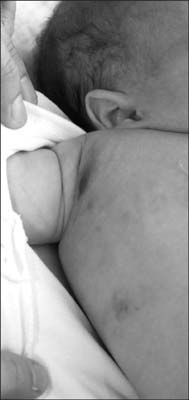Pediatr Gastroenterol Hepatol Nutr.
2014 Sep;17(3):191-195. 10.5223/pghn.2014.17.3.191.
Hemorrhagic Diathesis as the Presenting Symptom of Neonatal Cholestasis
- Affiliations
-
- 1Free University of Brussels, Universitair Ziekenhuis Brussel, Brussels, Belgium.
- 2Department of Pediatrics, Universitair Ziekenhuis Brussel, Brussels, Belgium. yvan.vandenplas@uzbrussel.be
- KMID: 1803120
- DOI: http://doi.org/10.5223/pghn.2014.17.3.191
Abstract
- A 4-week-old infant presented with a coagulation disorder resulting from a vitamin K deficiency. The vitamin K deficiency was caused by neonatal cholestasis due to biliary atresia. Jaundice, hepatomegaly and pale stools are the predominant presenting symptoms of biliary atresia, none of which were recognized in our patient before admission. However, the patient presented with bleeding caused by vitamin K deficiency. She was fully breastfed and had received adequate doses of vitamin K at birth and from the age of 1 week. In case of a hemorrhagic diathesis due to neonatal cholestasis, timely identification of treatable underlying disorders, in particular biliary atresia, is important because an early surgical intervention results in a better prognosis. Meticulous history taking and a thorough physical exam can be decisive for an early diagnosis and subsequent intervention.
MeSH Terms
Figure
Reference
-
1. Ijland MM, Pereira RR, Cornelissen EA. Incidence of late vitamin K deficiency bleeding in newborns in the Netherlands in 2005: evaluation of the current guideline. Eur J Pediatr. 2008; 167:165–169.
Article2. Moyer V, Freese DK, Whitington PF, Olson AD, Brewer F, Colletti RB, et al. North American Society for Pediatric Gastroenterology, Hepatology and Nutrition. Guideline for the evaluation of cholestatic jaundice in infants: recommendations of the North American Society for Pediatric Gastroenterology, Hepatology and Nutrition. J Pediatr Gastroenterol Nutr. 2004; 39:115–128.
Article3. McKiernan PJ. Neonatal cholestasis. Semin Neonatol. 2002; 7:153–165.
Article4. Chardot C. Biliary atresia. Orphanet J Rare Dis. 2006; 1:28.
Article5. Miyao M, Abiru H, Ozeki M, Kotani H, Tsuruyama T, Kobayashi N, et al. Subdural hemorrhage: A unique case involving secondary vitamin K deficiency bleeding due to biliary atresia. Forensic Sci Int. 2012; 221:e25–e29.
Article6. van den Anker JN, Sinaasappel M. Bleeding as presenting symptom of cholestasis. J Perinatol. 1993; 13:322–324.7. Petersen C, Davenport M. Aetiology of biliary atresia: what is actually known? Orphanet J Rare Dis. 2013; 8:128.
Article8. Roberts EA. Neonatal hepatitis syndrome. Semin Neonatol. 2003; 8:357–374.
Article
- Full Text Links
- Actions
-
Cited
- CITED
-
- Close
- Share
- Similar articles
-
- Beta Thalassemia Presenting with Neonatal Cholestasis and Extensive Hemosiderosis: A Case Report
- A Case of Neonatal Cholestasis Associated with Congenital Adrenal Hyperplasia
- A case of Dubin-Johnson Syndrome
- Evaluation of the Underlying Etiology and Long-Term Prognostic Factors in Neonatal Cholestasis
- Neonatal Cholestasis Associated with Congenital Hypopituitarism



